This post brought to you by Beadalon.com. Thanks Beadalon for sponsoring this post and helping me to share my love of DIY jewelry making.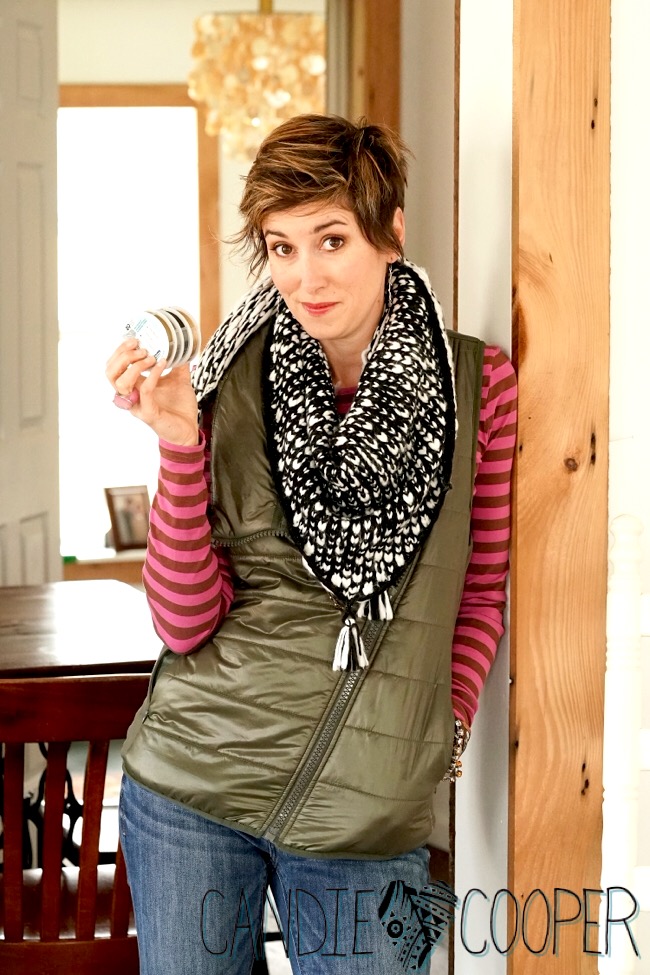 It’s one of the great mysteries of the universe.
It’s one of the great mysteries of the universe.
Well….the jewelry making universe anyway.
Beading wire.
This is nylon coated beading wire we are talking about. It’s flexible and used for stringing beads of all shapes and sizes. Beading wire is not used for wire wrapping stones. That’s a common confusion I’ve found.
There are so many different ones available and it can get really confusing. That’s why I created this post to help you understand the different types of beading wires used in jewelry making.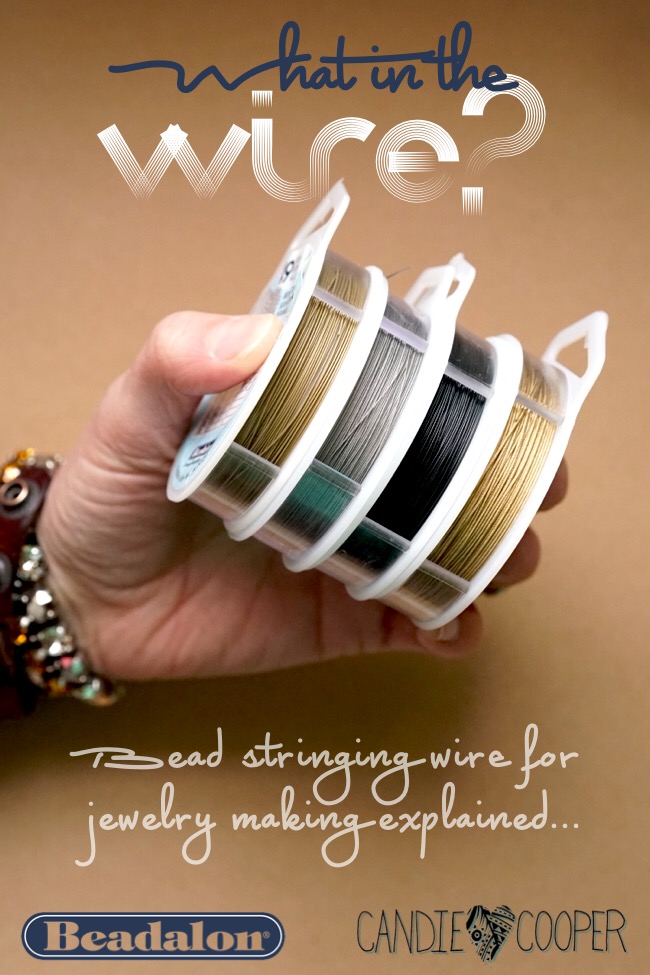
7 strand, 19 strand, this diameter, that diameter, but what if I’m stringing chunky gemstones or making an illusion necklace? So many jewelry design ideas, but where to start?
The first thing I ask myself is what am I stringing? Seed beads or heavy gemstones? I pulled this image from the Beadalon website so you can see what wires are good for what beads.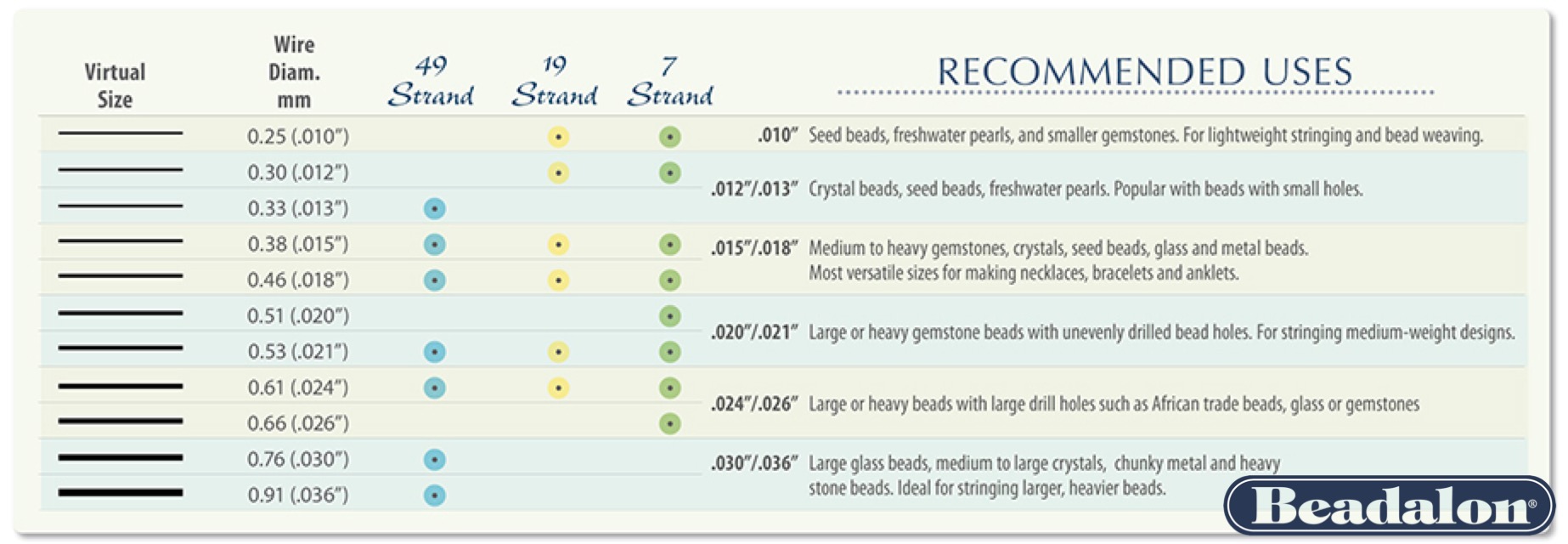 You can click on this image to make it bigger. From left to right:
You can click on this image to make it bigger. From left to right:
Virtual size is the thickness of the wire.
Wire diameter is just that–I usually speak in millimeters here on the blog (i.e. .018)
Strand count is how many tiny wires are twisted together to make the single wire. More strands equal more flexibility.
More wire diameters–those are simply recommendations for the type of bead you are stringing. For example, Beadalon recommends .010 diameter wire for seed beads.
Before I forget–did you know Beadalon wire is made right here in the USA?! I love that so much.
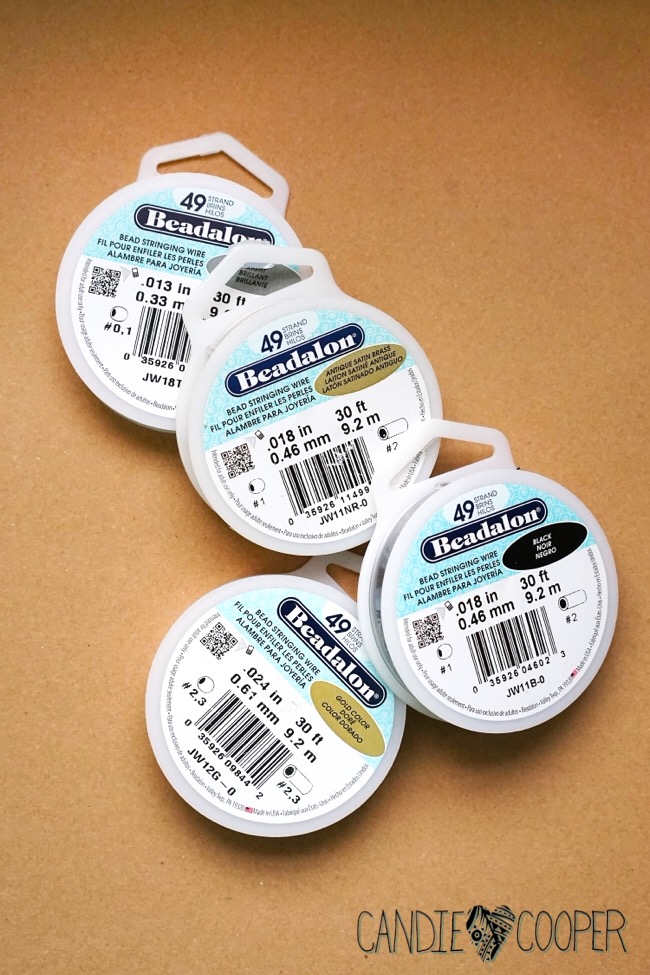 Ninety percent of my jewelry uses 49 strand beading wire because it’s my fave if you can’t tell. It’s also the most expensive. And while I get mine for pretty much free from Beadalon–I’d still use this or 19 strand in my jewelry projects because I want it to last. You can see I have a few different diameters here.
Ninety percent of my jewelry uses 49 strand beading wire because it’s my fave if you can’t tell. It’s also the most expensive. And while I get mine for pretty much free from Beadalon–I’d still use this or 19 strand in my jewelry projects because I want it to last. You can see I have a few different diameters here.
If you’re just getting into this DIY jewelry making world I suggest starting with 49 or 19 strand .018 mm diameter. It’s a great all-purpose choice for your first jewelry making projects.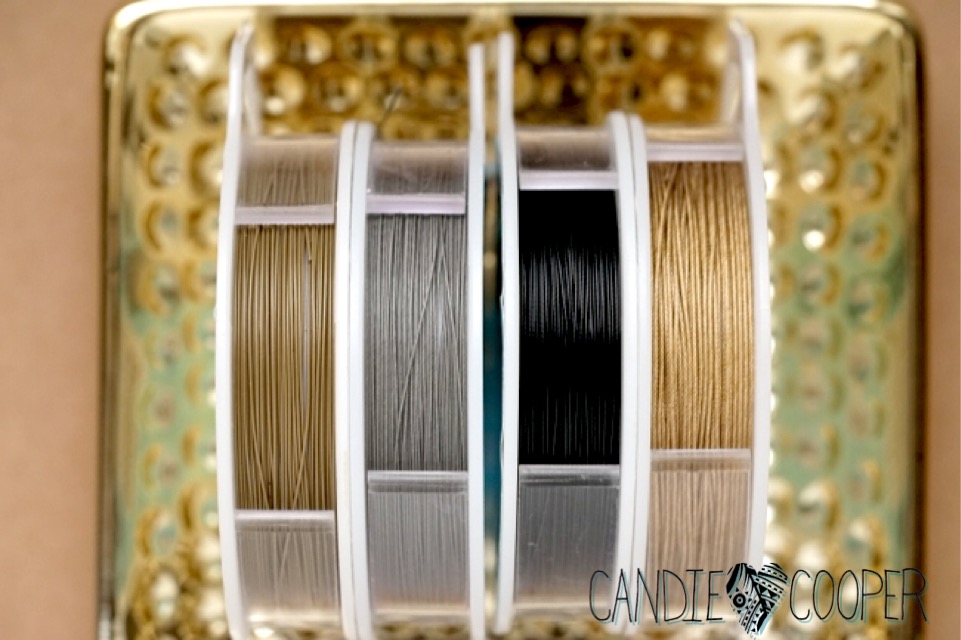 Beadalon wire also comes in a huge array of colors from neutrals like these to ones found in the rainbow. You can shop their site to see all of them.
Beadalon wire also comes in a huge array of colors from neutrals like these to ones found in the rainbow. You can shop their site to see all of them.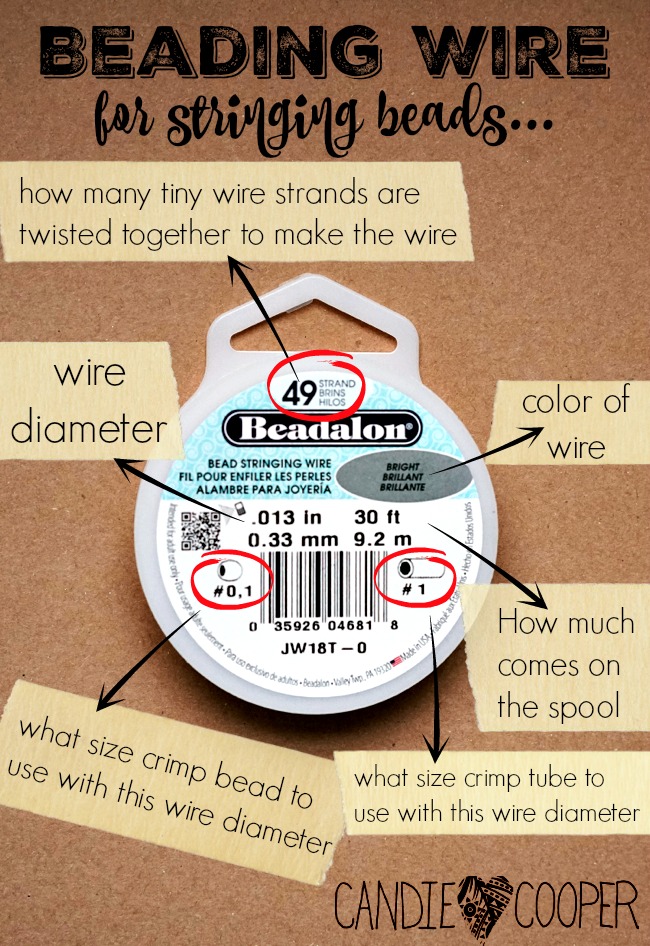 Lastly, one really important thing to pay attention to on the package is what size crimp bead or tube to use with that particular beading wire. Crimps secure the clasp and beads to the wire in DIY jewelry. See the #1 or #2? These numbers vary according to the wire diameter. There are #3 and #4 crimps as well. If you would use those with this wire, your piece would most likely fall apart because they are too big for this wire.
Lastly, one really important thing to pay attention to on the package is what size crimp bead or tube to use with that particular beading wire. Crimps secure the clasp and beads to the wire in DIY jewelry. See the #1 or #2? These numbers vary according to the wire diameter. There are #3 and #4 crimps as well. If you would use those with this wire, your piece would most likely fall apart because they are too big for this wire.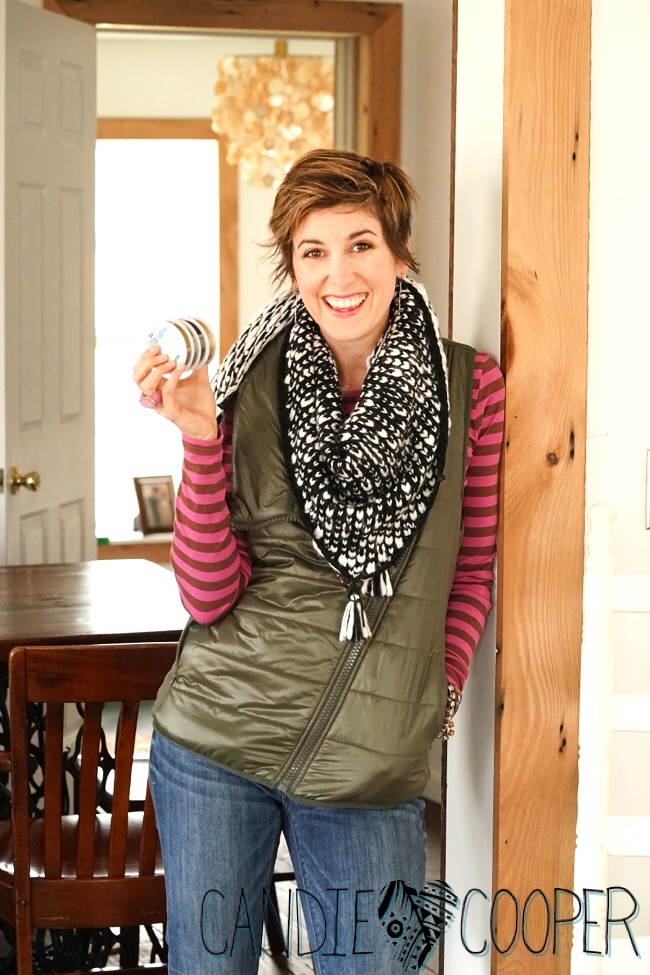 I hope this post has solved some of the mystery. The more you make, the more you learn…sometimes the hard way, I’ve found! Haha!
I hope this post has solved some of the mystery. The more you make, the more you learn…sometimes the hard way, I’ve found! Haha!
Special thanks again to Beadalon for keeping me locked and loaded on beading wire and sponsoring this post.
 Hi, I’m Candie. I design jewelry and crafts, author books, teach classes and host television programs. I thrive on simple ideas that anyone can achieve. I also love projects made from unexpected materials that stand the test of time. Join me as I lead a creative life!
Hi, I’m Candie. I design jewelry and crafts, author books, teach classes and host television programs. I thrive on simple ideas that anyone can achieve. I also love projects made from unexpected materials that stand the test of time. Join me as I lead a creative life! 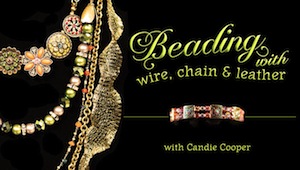





Oh my goodness….THANK YOU!!!!! I really needed this info.
Yayyyyy!! Glad I could help!
Thank you this had cleared up a lot for me.
thanks so much for this information it has been so helpful i once tried beading but got so frustrated because i did not research enough.
This was a very useful link. Thankyou. From Scotland.
No m m ore standing with a befuddled look on my face wondering which wire to use.
Thanks bunches!
Wow weee wow! I’ve been making Jewelry for over 20 years and this is the best F.Y.I. read I’ve ever come across! Tre Fab! Thank you for sharing!
Great information! Thanks!
Thank you so much. I learned more from this about beading wire than anything else I’ve seen so far..
Glad I found your pin. Now I know! My bracelets have been too stressed and were breaking!
I’m repairing a piece I love right now because I didn’t have this info. Luckily, I was home safe and sound when it broke and I have each and every little piece. Thanks-I’ve looked at that labeled SO many times and never noticed the crimp information!
This is a most useful coiitnbutron to the debate
Your post was really informative and cleared a lot of my doubts. But in India, I got a spool of beading wire which has no details of strands used or diameter or anything in fact. Any suggestions on how to estimate size?
Maybe if you have a very tiny measuring tool to find out the diameter of the wire. The crimp shouldn’t be too tight with the two wires through it or too big–it should just have a tiny amount of space on the inside.
Thank you this info glad to know it was very helpful
Started to do necklaces won’t want them to fall apart
Thank you for sharing your knowledge, I am just starting to try my hand at making necklaces.
Thank you so much! The info on the 49 wire rolls was wonderful. I did not know that at all.
Hi Donna! It’s on all the Beadalon beading wire spools. Yay! I love that they don’t keep us “hanging”on that info. Haha 😉
I read this after a week of frustration trying to make my crimps hold on some lanyards I was making. What a revelation to find out my crimp tubes were too large! And the information was on the label the whole time! I had no idea they should be smaller. I will keep this chart from now on! Thank you, Candie Cooper and Beadalon!
So happy to hear!! 🙂
Ohh my! I had no idea the crimp info was on the label! Haha
Thank-You so much! :0)
– Trish
I am just learning. Thank you for the informative explanation. Now I’ll know how to read beadalon packages.
Hey Candie, I have a question. I am making a necklace with multiple strands of seed beads strung on Beadalon 7 strand .015 wire. It seems that the beads are not heavy enough to straighten the wire and all of the strands have a slight wave in them from being wrapped on the spool. Is there a way to straighten the wire so it doesn’t have this wave?
I had no idea what all those numbers meant on the spool. Thank you so much!!
Awesome Info!! Thank you!!
I love to learn new things and this I have done today. Thank you
Thank you very much. This demystified all that numbers to me ☺
I really appreciate your sharing this information Ms. Cooper. I have been wondering what I was doing wrong and why my necklaces and bracelets kept breaking. It is so embarrassing to have a gift break after the second wearing.
I’ve been beading about 6 months now. Some of the info you gave I sorta knew from trial and error but I still learned a lot. Thank you for taking the time to explain it all. It can be confusing!
Thank you fir this very helpful explanation. It is totally comprehensive.
Thank you for clearing this up for me! I never paid attention to the crimp info! Very handy. I love using the thinner wire for glass seed beads with pendant charms. Any way I could get a free spool of wire lol?
Thank you so much, that helped me so much, now I know how to look at each roll of wire! Thanks to Beadalon for sponsoring you also.
Thank you so much. Good information to have. Thoughtful of you to share your knowledge.
Thanks for that! I am trying out some wire weaving/wrapping and thought the 7 strand silver would be ideal, however it’s far too bouncy and doesn’t hold a bend.
That’s when I realised it must be for bead stringing only but couldn’t find information anywhere.
This has totally cleared it up for me thank you so much!!
Now all I have to do is find something to do with two rolls of beading wire! My plan is to try crocheting with it. Not sure what yet.
You can absolutely crochet with it!
I’m a brand new beginner to jewelry making. One question I did not see is how to determine whether a wire is dead soft, half hard, etc. when shopping for wire. I’m very, very confused!! I will be so thankful for your help.
Hi Jean! Those terms are referring to hard wires–this is super flexible beading wire. 🙂 But for your question–those usually refer to more precious metal wires (sterling, gold etc…), the catalog description or packaging will give you the scoop.
Wonderfully complete info! I’ve been making jewelry for at least 5 years and never knew about the crimp info on the label. Now I understand the reasons for what I’m supposed to use and I really like that. Thank you!
This was soooo helpful. I’m just getting back into jewelry making and now I understand why the crimps were so frustrating. With the information I will enjoy making jewelry again. Thank you!
Jeanne Hanson
thank you, i’ve saved the graphics. i can never remember the weights of wire to use for what… 🙂
Thank you for this information. I am a beginner. I just make a necklace that felt apart because I use the wrong size crimp tube
Hello …a very informative article
1question i had-is there a different wire we use for making necklace and bracelet.
Please let me know
Struggling big time understanding it
Thanks
Anu
Thank you so much for this. I am a beginner and plan to self teach so that i may find my own creativity. I have desired to make jewelry for some time. I recently decided to jump in and see…. Im excited for my journey. This was helpful and informing.
Thank you. There is light at the end of the tunnel. Sounds silly now but I have been having so much trouble with jewellery breaking and getting frustrated so a deep and heartfelt thanks
Thanks so very much! Very informative. It is a VERY confusing thing. Thanks for making it so easy to understand!
Mahalooooo ~ you made this super clear for a beginner ~ soooooo appreciated!
I’m trying to learn bracelets I do stretchy but now I want to make loose bracelets that will require crimp beads and all the fun stuff. I bought 20 Guage wire 0.81 mm to make round earrings but I’m not sure how to finish my round earring. Will it take crimp beads and what size.
Hello I am in such dire need of knowing the correct size of wire needed to make “Large Hoop Earrings” at least 70mm in size. I wish to add beads to them, as well I have spent countless dollars buying the wrong gauge wire… The wrong size beads because the beads didn’t fit the Wire!!
Help… I just found the correct size of the earring I want to make 70mm now I need correct bead size and wire gauge size!!! Please Help!!!!
I am getting into various projects, mostly Christmas decor and I can never tell how much weight the wires can hold. I have made beaded strands to hold “witch” balls and have just doubled the wire but would be interested to have more knowledge about wire strength.